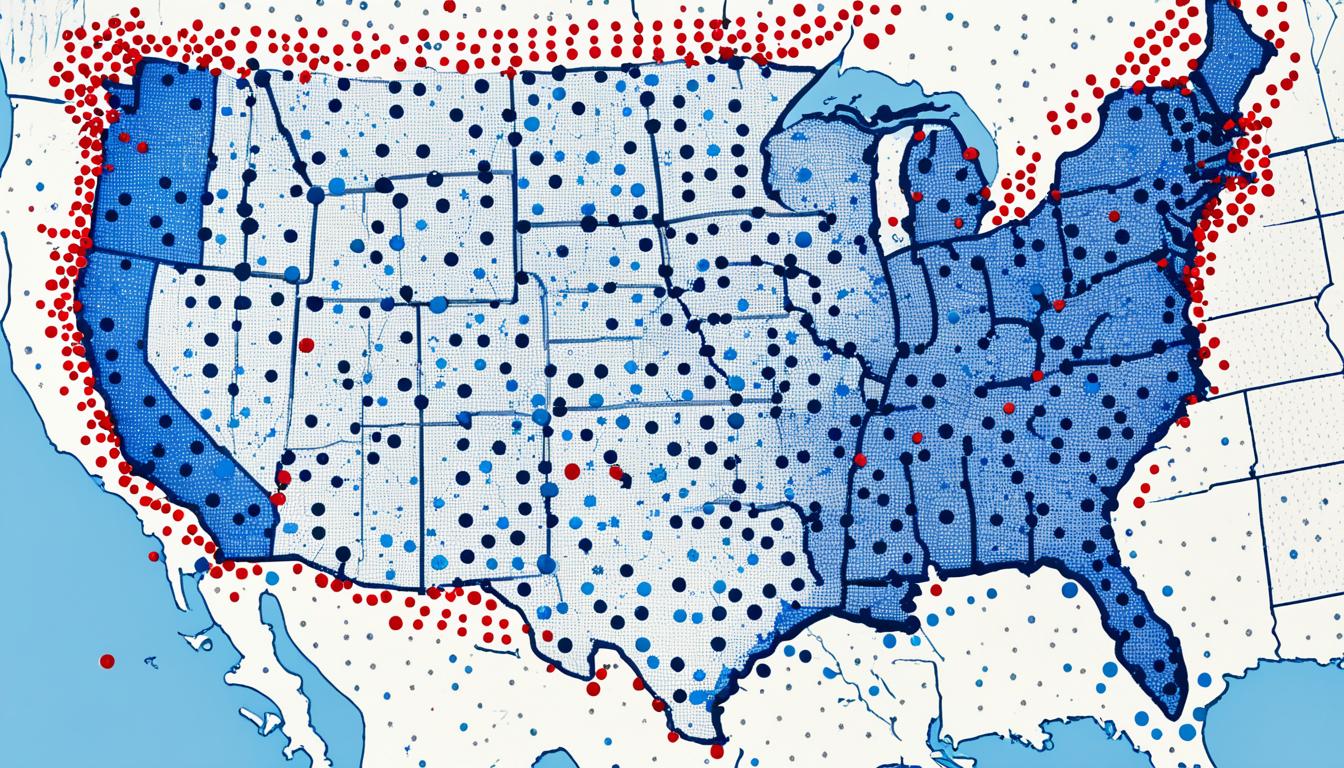As of 2022, the FBI says there are over 800,000 full-time police officers in America1. About 137,000 of them work for the federal government. The rest work for local and state police forces1. The number of officers can vary a lot by location. This means some places have more police than others1. It’s key to watch how police numbers change over time. Trends in crime, population, and budgets affect how many officers a place might have1.
Key Takeaways
- The United States has over 800,000 full-time sworn law enforcement officers as of 2022.
- Approximately 137,000 of these officers work for federal agencies, while the majority are employed by state and local police departments.
- The number of police officers per capita can vary significantly across different states and municipalities.
- Factors such as population growth, crime rates, and budgetary constraints can influence police staffing levels over time.
- Detailed occupation information and statistics related to police officers in the US are available from various government surveys and data sources.
Overview of Law Enforcement in the United States
In the United States, law enforcement is a large system. It includes federal, state, and local agencies. These work to keep everyone safe and obey the law2. Most states have county-level police, but Alaska, Hawaii, and Connecticut do not2. Cyber policing is mostly done by the federal government. However, state and local police also use technology for law enforcement2.
Types of Law Enforcement Agencies
Local law enforcement gets its power from local governments2. At the state level, officials like fish and game wardens watch over environmental laws2. Each state may assign different duties to its law enforcement. For example, some have state police and highway patrol officers.
Roles and Responsibilities of Police Officers
In cities, police departments have chiefs who lead them. There is also a chain of command, including commanders and lieutenants2. New officers start at the bottom and move up with experience and training2. As they move up, their job’s responsibility grows, and they earn more money2.
Some in law enforcement have specialized roles, like forensic analysts. These jobs need specific education and skills2. Many police departments now focus on working closely with local people. This helps prevent crime by building trust and using new methods.
3 VA Police protect VA Medical and Health Care Centers. They also work in places like Puerto Rico3. They do investigations and crime prevention, plus patrols for safety3. To join VA Police, candidates need a background in law enforcement or a related field.
“The majority of states have law enforcement working at the county level, with only three exceptions: Alaska, Hawaii, and Connecticut.”2
A survey from 2019 showed a big gap in how people see police treatment. Most black adults believe they’re treated less fairly than white adults by the police. White adults’ views were lower in comparison4. Many said the criminal justice system treats black people worse. Most believe unfair stops happen due to race4. Notably, 9% of white adults shared this experience4.
There’s also a perception that police actions against black people are more common. This results in black people often feeling targeted by the police because of their race. A higher percentage of black adults compared to whites shared experiencing this suspicion4.
| Perception of Police Treatment | Black Adults | White Adults |
|---|---|---|
| Believe black people are treated less fairly than whites when dealing with police | 84% | 63% |
| Believe the U.S. criminal justice system treats black people less fairly | 87% | 61% |
| Report being unfairly stopped by police due to race or ethnicity | 44% | 9% |
| State they have been unfairly stopped by police due to race or ethnicity | 59% (black men), 31% (black women) | N/A |
| Say they have been perceived as suspicious due to race or ethnicity | 65% | 25% |
3 The VA will now have VA Police wear body cameras. This is due to a recent Executive Order and law3. The goal is to have these cameras everywhere by the end of 2023. They will record both video and audio3.
Footage will be kept in a secure digital place. How long it’s kept depends on the case3. The videos will help in investigations and in court. But, their use will be watched over by local VA Police Chiefs or their appointees3.
When it comes to the amount of force used, things are seen differently. Only about a third of black adults feel the force used is right for everyone. There is also a view that the police hold some groups more accountable than others4.
Fatal encounters between black people and the police are seen in two ways. Some believe they signal larger problems, while others think they’re separate events4. In 2016, most officers thought protests against these incidents were anti-police4. And, many officers feel these events have made their jobs harder and increased tension with black communities4.
Federal Law Enforcement Agencies
The Department of Justice (DOJ) and the Department of Homeland Security (DHS) are in charge at the federal level5. They oversee most law enforcement across the U.S. These agencies enforce federal laws and handle big threats to national security. These are too big for local officers to manage6.
Major Federal Agencies
Major federal agencies like the FBI, DEA, ATF, and more have important roles5. They have power to investigate widely, even crossing state and country borders. This helps them enforce laws and protect against threats that local police might not catch6.
Jurisdiction and Powers
Federal agencies have lots of power and reach to do their job well. They can look into and enforce many laws, from national security to organized crime6. They often work with local law to keep everyone safe and secure7.
In 2020, over 137,000 full-time officers were working in federal law enforcement across the U.S5. These officers could make arrests and carry guns. Many of them worked within the Homeland Security and Justice Departments. Most were investigating crimes5.
Notably, about 15% of these officers and 13% of their supervisors were women in 20205. In terms of race, the majority were white. However, there was good representation from Hispanic and black communities too5.
The Department of Homeland Security and its Inspectors General’s Office had almost half of these officers5. Customs and Border Protection employed the most, nearly 35% of the total5.
“Federal law enforcement agencies possess extensive powers and jurisdiction that enable them to effectively carry out their responsibilities.”
These agencies are crucial in keeping the U.S. safe and enforcing the law. Their knowledge and broad reach are key parts of the nation’s safety and crime fighting plan657.
State and Local Law Enforcement Agencies
Each U.S. state, along with federal agencies, has its own police forces8. For example, they have state police that cover everywhere within a state. This includes highway patrols that keep roads safe. They often help local police in times of need.
There are also investigative units within states. They cooperate closely with the state’s top lawyer, like the California Department of Justice8.
At a smaller level, town and city police and sheriff’s offices are hard at work. They serve specific areas within a state. The U.S. has more than 18,000 of these local police forces9.
However, these local police forces can differ a lot. This is because they must follow the laws set by their town, county, or state9.
| Law Enforcement Agency Type | Number |
|---|---|
| Federal Agencies | 73 |
| Primary State Agencies | 50 |
| Special Jurisdiction Agencies | 1,733 |
| Sheriff’s Offices | 3,063 |
| City, County, Tribal, and Regional Police Departments | 12,501 |
Our nation’s security rests on the combined efforts of many law enforcement groups. These can be from the highest level, like the FBI, to our local police10. Even though they have different setups and rules, they all aim to keep peace and protect the people9.
how many police officers in the us
Many people are curious about the number of police officers in the United States. This number keeps changing because of various trends and needs in law enforcement11. Currently, there are over 800,000 full-time police officers across the country11. Although this is a big number, it’s a bit lower than before. Some police departments find it hard to hire new officers and keep the ones they have because of budget issues and many officers retiring11.
National Statistics on Police Officer Employment
Looking at the whole nation’s numbers can show us a lot about police work. In 2022, 118 police officers were killed on duty, and 60 of those deaths were caused by someone using a firearm against them11. These numbers have been going up since the 1990s, but there were 11 fewer deaths in 2022 than the year before11. There were also 58 officers who died accidentally, with the biggest part happening in car accidents11.
The South of the country saw the most police deaths in 2022, with 66 officers losing their lives. The West had the next highest number, with 22 deaths11. Surprisingly, being a police officer didn’t make the list of the top 10 most dangerous jobs in the US in 2020. The fatality rate for police officers was about 13 deaths per 100,000 officers. For comparison, jobs in fishing and hunting had a much higher death rate11.
Trends in Police Staffing Levels
It’s key to also look at long-term trends in police staffing12. One big issue is that police departments are finding it tough to get new recruits and keep current officers. This has led to a lack of officers in many places12. Over the years, from 1972 to 2017, more than 500 towns and cities in the US have stopped having their own police forces12. Also, in the past two years, 12 small towns have had to do without their local police12.
There are several reasons for these troubles with staffing12. For instance, more officers are choosing to quit, and more are retiring. The number of people applying for police jobs has dropped, leading to fewer new officers joining police departments12. This situation is seen in places like Goodhue County, where they received a lot fewer job applications recently than they used to12.
Although police departments facing these issues, some places that stopped having local police have done well. In various towns, crime rates stayed the same even without a local police department12. For example, Lott, Texas, disbanded its police department and now has fewer crimes. The county officers that now serve the town are able to respond quickly to calls12. Washburn, Illinois, is another example. They replaced their local police with county officers and have been happy with the service12.
The drop in police numbers is a nationwide challenge13. Places like Tulsa, Oklahoma, are struggling to fill their needed police jobs. This city of 411,000 people has 160 open spots for officers13. Since the start of the pandemic, the number of local government workers, including police, has gone down13. There’s been a decrease in the number of police employees from 2020 to 202213.
The changes in police staffing reflect the many complex issues they face. They are trying to adapt while still meeting the needs of the public. This includes dealing with retirements, recruitment, and the impact of the pandemic on their workforce13.
Police Department Sizes and Distribution
Across the United States, police departments differ greatly in size and where they are located14. There are over 1 million public safety officers in the US. Among them, 906,037 work full-time in law enforcement, while 94,275 are part-timers14. However, police employment has slightly dropped from 1,019,246 officers in 2008 to 1,000,312 in 201914.
This drop represented a 6% decrease across all state and local government employees. Policemen and women account for a significant portion of these workers14.
Large vs. Small Police Departments
In the US, police departments come in many different sizes15. There are over 12,200 local police departments and about 3,000 sheriff’s offices15. Many local departments, nearly half, have less than 10 officers. Three quarters of them have no more than 24, and almost all have under 50 sworn officers15.
But, about 5% of all police agencies have 100 or more officers. These few large departments handle over 60% of the country’s law enforcers15.
The number of police per person changes a lot depending on the area16. For instance, Washington, DC has the most police per person. Then comes New York, New Jersey, Louisiana, and finally Wyoming16.
In cities with more than 50,000 people, there were about 17 officers for every 10,000 residents in 201216. Larger departments mainly work in more populous areas16.
| City | Officers per 10,000 Residents | Total Law Enforcement Employees per 10,000 Residents |
|---|---|---|
| Washington, DC | 61.0 | 68.5 |
| Baltimore, MD | 47.0 | 53.4 |
| Chicago, IL | 44.0 | 47.1 |
| Wilmington, DE | 43.0 | 51.0 |
| Detroit, MI | 36.3 | N/A |
| Los Angeles, CA | 25.9 | 33.6 |
| Houston, TX | 24.4 | N/A |
| New York, NY | 41.7 | N/A |
| Minneapolis, MN | 21.8 | N/A |
| Portland, ME | 23.3 | N/A |
The variety in police department sizes and locations affects their work and how they engage with communities15. Smaller departments often have to work harder with fewer resources. They also focus more on connecting with their local area15.
On the other hand, big city departments have more to work with. They can better meet their community’s needs because of their size and resources15.
Police Workforce Demographics
The makeup of the police in the U.S. has been a big focus lately. Men mainly serve as police officers, with only about 16.8% being women17. The force sees different races and ethnic backgrounds too. Whites make up 60.0%, Hispanics or Latinos 18.2%, Black or African Americans 12.9%, and other groups 4.6%17.
About 39 years old is the average age for a cop, and 7% are LGBT17. Nearly half of officers have a bachelor’s degree, while about a quarter have an associate’s degree. Only 11% have a high school diploma. Cops with a Master’s degree tend to make more money, earning around $60,863 yearly17.
Women officers earn 94% of what men make17. But, there are not as many women in higher positions like deputy sheriff-k9 handler or fugitive investigator17. The majority of police officers work for government companies, staying about 1-2 years on average17.
The main language among cops is Spanish at 70.5%. French and Arabic follow at 4.8% and 3.3%, respectively17. The unemployment rate stays low, between 1-2%, from 2008 to recent figures17.
“Police officers are 74% more likely to work at government companies compared to private companies.”17
The police force’s demographics tell us a lot. They show us where we need to work harder to bring in more people from different backgrounds. It’s important for the police to look like the communities they protect17.
The demands and growth chances in policing impact who joins the force18. You typically need a high school diploma or more to apply. Skills like good talking, empathy, and leadership are key for moving up18.
Looking at where cops are in the U.S., we see some cool trends19. Places like Louisiana have lots of police per 1,000 people. But, Washington and Utah don’t have as many. Across the country, there are about 3.5 cops for every 1,000 Americans19.
The average pay for a cop each year is $67,803, which is good. But, their pay hasn’t gone up as much in the past ten years as it should have. Cops only got a 3% raise, while the average worker got 6%19.
To sum up, we must keep working on making the police force more diverse and fair. Knowing these facts can help us choose better ways to welcome and help officers be their best. This way, the police can truly be part of the communities they serve171819.,,
Factors Influencing Police Officer Numbers
In America, how many police officers work depends on several things like how many people live there, how much crime happens, and the money available20. When more people live in an area, they often need more police to keep everyone safe. This is true in places where the population is growing20. And, when crime goes up, the need for police also increases20.
Population Growth and Crime Rates
When a community gets bigger, police departments have to grow too to meet the increasing needs20. And, if crime goes up, departments will need even more police to handle investigations and keep the peace20.
Funding and Budgetary Constraints
How much money a police department has affects how many officers they can hire and keep on staff20. Sometimes, with not enough money, departments face challenges. They might have to cut back, affecting their ability to keep the community safe21. It’s important for departments to carefully plan how many officers they need, especially with new job openings and people retiring21.
Keeping officers happy and hired right makes them stay longer. Using the right ways to find and choose new officers is key for a police department21. They should also work on having a good reputation as a place to work. This brings in great, diverse talent and saves money when hiring21.
Having enough staff matters a lot when it comes to how quickly police can get to emergencies22. Slow responses to big problems can be very harmful. Quicker responses help catch criminals and save lives22. Now, with less new officers joining and many leaving, police might not be able to help as quickly as needed22.
The number of police in the U.S. changes with population, crime, and money ups and downs. Smart planning, finding, and keeping officers, and quick response times are key for good police work202122.
Law Enforcement Statistics by State
Looking at data state by state shows big differences in police numbers and resources23. The Census Bureau’s 2021 Annual Survey of Public Employment and Payroll has detailed info. It shows the amount of police at state, county, and city levels.
State and Local Law Enforcement Headcounts
Different states have very different police force sizes23. For example, California, Texas, and New York have over 100,000 officers each. California has the most, with around 148,00023. But states like Utah, Oregon, and Washington have fewer officers per 100,000 people.
There’s also a wide variation in the number of police supervisors and patrol officers23. New York has many supervisors, with over 10,450. Florida, California, and Texas follow23. California, Texas, New York, and Florida also have the most patrol officers23.
While most places keep a steady number of officers, some have seen big changes23. Policymakers and law enforcement agencies need to understand these trends. It helps in managing recruitment and resources better.
The ASPEP data gives deep insights into U.S. law enforcement. It shows why a detailed, state-focused approach is needed to tackle their challenges242523.
Challenges and Issues in Law Enforcement Staffing
Recently, the field of law enforcement has seen many obstacles when it comes to hiring enough people26. Fewer folks want to join the police force. This has led to a shortage of officers in some areas. Also, a lot of experienced officers are leaving or retiring. This makes the situation even worse26. To fight these issues, police departments are trying different things. They’re offering better pay, more training, and they’re trying to work closely with the community. They hope this will make more people want to become police officers and stay in the job.
Recruitment and Retention Efforts
In 2020 and 2021, the total number of officers across police departments dropped by 3.48%26. The hiring of new officers dropped significantly in 2020 but improved in 2021, it’s still lower than in 201926. Many officers are also quitting or retiring. In 2021, there was a big jump in these numbers compared to 201926. Similarly, police retirements have been on the rise since 2019, with a notable increase in 202126.
These staffing issues are not just at a national level. Take the New York City Police Department (NYPD) for example. They saw a big increase in officers leaving from 2020 to 202227. The total number of NYPD officers has also dropped over the years27. Los Angeles had more shootings after their police budget was cut. This caused a drop in police numbers, leading to public safety concerns27.
To fix the problem with not enough officers, different strategies are being used. A 2019 survey showed most agencies have a hard time finding qualified people27. Another report in 2019 mentioned that many agencies are getting fewer applicants now than before27. By June 2021, there was less hiring in the police departments of various sizes. This shows the challenge isn’t getting any easier27.
The big issue now is finding the right people for police work and keeping them happy in the job28. To solve this, there are over 50 ideas, like changing who can become an officer, updating how we hire them, and focusing on their health and getting a variety of candidates28. The report underlines keeping a skilled, dedicated, and diverse force of officers is crucial for keeping everyone safe and building trust with the community28.
Conclusion
In the United States, over 800,000 police officers are at work as of 2022. Many of them work for federal agencies, while others are in state and local police forces29. The numbers change a lot in different places, based on how big the area is, how much crime there is, and the funds they have29.
Keeping the police ranks strong and diverse is very important. This makes sure they’re ready to keep everyone safe all over America. They face some tough challenges like finding and keeping officers and making sure the force looks like the communities they protect29.
The need for new ways to prevent crime is growing. Police are looking into programs that stop crime before it happens. They’re checking to see if these new methods work better than the old ways30. They also worry about the downsides of trying to stop crimes before they start, like moving crime to other areas. Using technology to help prevent crime is also a big topic30.
The feelings about police work among officers are mixed. Many believe they are doing a good job getting along with people, especially with white and Hispanic people31. But, there’s worry about being too harsh, not trusting each other enough, and not having as good of a relationship with the Black community31.
Making things better and building stronger bonds with the people they serve is key. This is important for the police to do well and be supported by everyone in the United States31.
FAQ
How many police officers are there in the United States?
The FBI says that by 2022, there were more than 800,000 full-time sworn officers in the U.S.
What is the breakdown of federal, state, and local law enforcement agencies in the US?
About 137,000 officers are part of federal agencies. The majority work in states and local areas.
How do the number of police officers vary across different states and municipalities?
Police presence changes a lot between states and cities. Some have more officers than others.
What types of law enforcement agencies exist in the United States?
The U.S. has about 18,000 law enforcement groups. This includes agencies at all levels and types.
What are the key federal law enforcement agencies in the US?
Major federal groups are the FBI, DEA, ATF, U.S. Marshals, U.S. Border Patrol, ICE, and Secret Service.
How are state and local law enforcement agencies organized in the US?
Each state has its own police and sheriffs. Most local groups are county or city police.
What trends have been observed in police staffing levels in the US?
Recent years have seen fewer police hired. This is due to less interest, retirement, and money issues.
How do the sizes of police departments vary across the country?
Police forces can be very different sizes. This ranges from big city groups to small rural ones.
What is the demographic composition of the police workforce in the US?
Policemen are mostly men. Women are about 15% of all police. Most are white, then Black, Hispanic, and others.
What factors influence the number of police officers employed in the US?
How many officers are employed comes from population growth, crime rates, and available money.
How do state-by-state and local-level statistics on law enforcement differ from national-level data?
Local statistics can show big differences in police numbers and where they are. The 2021 ASPEP from the Census Bureau does this.
What challenges have police departments faced in terms of staffing and workforce issues?
Hiring has been hard for many police. Fewer want to be officers. Many are retiring, making staffing short in some places.
Source Links
- https://www.census.gov/newsroom/stories/police-week.html
- https://www.allcriminaljusticeschools.com/law-enforcement/
- https://department.va.gov/about/va-police/
- https://www.pewresearch.org/short-reads/2020/06/03/10-things-we-know-about-race-and-policing-in-the-u-s/
- https://bjs.ojp.gov/document/fleo20st.pdf
- https://en.wikipedia.org/wiki/Federal_law_enforcement_in_the_United_States
- https://www.eeoc.gov/advancing-diversity-law-enforcement
- https://en.wikipedia.org/wiki/Law_enforcement_in_the_United_States
- https://www.justice.gov/d9/policing_101_content.pdf
- https://en.wikipedia.org/wiki/List_of_United_States_state_and_local_law_enforcement_agencies
- https://www.usafacts.org/articles/how-many-police-officers-die-in-the-line-of-duty/
- https://www.nbcnews.com/news/us-news/us-experiencing-police-hiring-crisis-rcna103600
- https://www.themarshallproject.org/2023/01/21/police-hiring-government-jobs-decline
- https://usafacts.org/articles/police-departments-explained/
- https://www.washingtonpost.com/nation/2021/05/08/most-police-departments-america-are-small-thats-partly-why-changing-policing-is-difficult-experts-say/
- https://www.governing.com/archive/gov-cities-with-the-greatest-police-presence-most-officers-per-capita.html
- https://www.zippia.com/police-officer-jobs/demographics/
- https://www.bls.gov/ooh/protective-service/police-and-detectives.htm
- https://www.safehome.org/resources/states-with-most-police/
- https://www.ojp.gov/pdffiles1/nij/197925.pdf
- https://www.theiacp.org/sites/default/files/2018-08/BP-RecruitmentRetentionandTurnover.pdf
- https://www.crimrxiv.com/pub/02md8eqk
- https://worldpopulationreview.com/state-rankings/police-officers-by-state
- https://www.pewresearch.org/short-reads/2024/04/24/what-the-data-says-about-crime-in-the-us/
- https://policeepi.uic.edu/law-enforcement-safety/
- https://www.policeforum.org/workforcemarch2022
- https://americafirstpolicy.com/issues/addressing-the-challenges-of-recruiting-and-retention-in-law-enforcement
- https://www.justice.gov/opa/pr/justice-department-releases-report-recommendations-law-enforcement-agencies-facing
- https://icma.org/sites/default/files/305747_Analysis of Police Department Staffing _ McCabe.pdf
- https://nap.nationalacademies.org/read/24928/chapter/10
- https://www.pewresearch.org/social-trends/2017/01/11/police-and-the-community/











